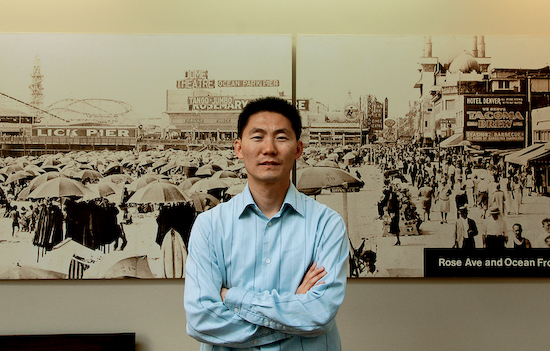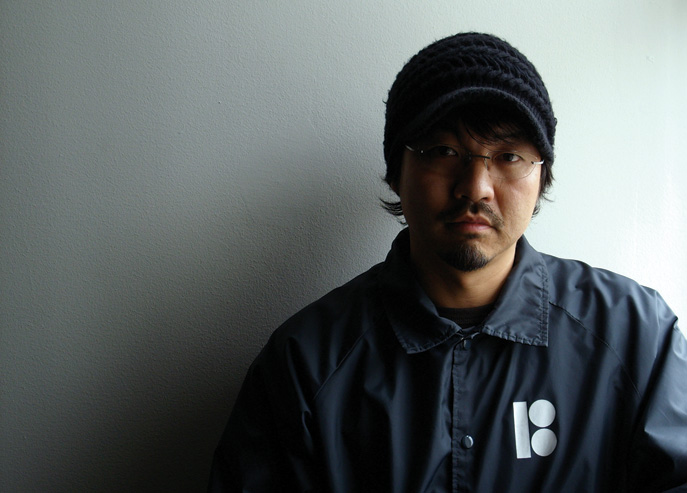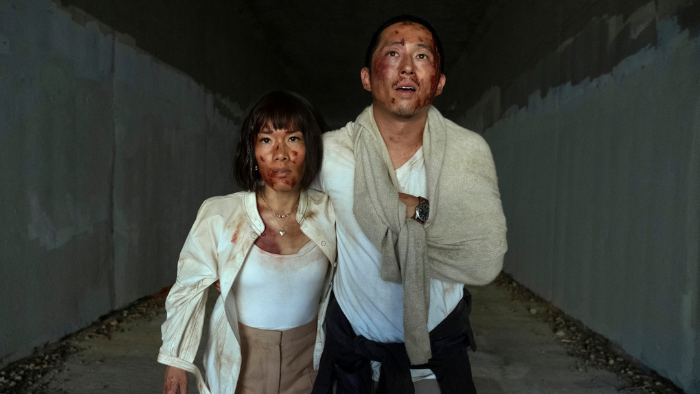By Do Kim
On April 29, 1992, I sat helpless in my college dorm room in Cambridge, glued to my TV, as images of a burning Koreatown flashed before my eyes. While a reporter was interviewing looters at a Kinney shoe store, I realized that was just a few blocks from my parents’ home. My heart stopped.
[ad#336]
Sa-i-gu survives in the collective memory of many Americans, though some remember the worst civil disorder in American history as a criminal insurrection, others recall a “rebellion” that served as a desperate call for help from disadvantaged Americans living in intolerable conditions. Still, others will relive the riots as the dissolution of their American Dream.
Though Americans may ardently disagree about how to interpret Sa-i-gu, there is no question that it commanded the attention of the whole nation. But now, 16 years later, it is nothing more than a forgotten memory, shaken off like a bad dream.
However, Korean American merchants who saw their whole life’s work go up in flames have not had the luxury of simply forgetting. Many were unable to recover from the financial and psychological shock. They were victimized also by a political system that conveniently ignored their voices pleading for help in the aftermath of the upheaval.
For me, Sa-i-gu became a defining moment in my life. Although at the time I was 3,000 miles away from the violence and destruction, a voice inside me screamed, “Do something!”
[ad#336]
How could I not, after all, as someone who, the summer before Sa-i-gu, had worked on a coalition called the Black-Korean Alliance (BKA) in Los Angeles that was formed to mediate tensions between African Americans and Korean Americans? Its formation in the spring of 1997 was spurred by the killing of four Korean merchants in South L.A. in a span of just one month, and became all the more relevant following the tragic 1991 shooting death of 15-year-old Latasha Harlins by Soon Ja Du in a South Central liquor store.
After the riots, I organized African American and Korean American students in Boston to raise $5,000 for the BKA. More important than the money, I wanted to prove that African Americans and Korean Americans could work together for a common good even under difficult circumstances. The mainstream media had shown us repeated images suggesting the contrary.
Although I had planned to go to law school immediately after I graduated from college, I returned home to Koreatown instead to help rebuild my community. What became painfully apparent during Sa-i-gu was that Korean Americans remained powerless to elicit help from our political leaders because our community had a vacuum of its own leadership. As I worked with a newly formed 1.5- and second-generation coalition group to advocate for the rights of Korean 4.29 victims, it became clear that these younger U.S.-reared KAs would have to become the mouthpiece for our struggling immigrant parents’ generation.
Unfortunately, 16 years later, the merchant coalition group has long since disbanded, as has the BKA, and the economic condition of high unemployment in South Los Angeles remains the same, ripe for the fire next time. And we still live in a Los Angeles that is still more diverse than any other place in the world.
That’s why, 16 years later, the need for developing community leaders is as important today as it was back in 1992 — but not just any kind of leader. We need peacemakers and bridge builders who can work across racial and ethnic lines on issues that impact all of our diverse communities, as well as demand accountability from mainstream institutions.
I place hope in one promising legacy of Sa-i-gu: a youth leadership program I founded and originally ran through the Korean Youth and Community Center, but now expanded and operated by The K.W. Lee Center for Leadership. The Korean American Youth Leaders in Training (KAYLT) program is an eight-week community organizing program for high school and college youth that strives to instill in them “community consciousness and conscience” — values inspired by the Center’s namesake. K.W. Lee is a veteran investigative journalist whose work has helped win an innocent man his freedom and put corrupt politicians in jail.
He also ran the English-language Korea Times Weekly in the early 1990s, and in his later years, has been embraced as a popular college lecturer and conference speaker. KA youth appreciate his blunt speaking style aimed at shaking people into truth and justice-seeking action. The kind of action KAYLT college interns took in 2006 when they developed a Sa-i-gu curriculum called “Roots, Riots and Reflections,” which addresses racial stereotypes, economic disparity, the Rodney King incident, media, violence and self-identity.
Already, Hollywood High School and Los Angeles High School have implemented the curriculum in their social justice and English classes. The K.W. Lee Center hopes to expand the Sa-i-gu curriculum into other schools so that the legacy of those tragic days in 1992 is not forgotten.
If we have learned anything from Sa-i-gu, it is that our community needs to develop the next generation of Korean American leaders who can advocate for our own community while also maintaining the larger vision to build coalitions with other racial minorities and mainstream society. The only way we can attempt to achieve equality is to partner with them to fight for the rights of all people.
Do Kim is a civil rights attorney and board president of The K.W. Lee Center for Leadership.
[ad#336]
Witness to Sa-i-gu Sees Troubling Similarities Between 1992 and 2008
> By Arvli Ward
I’m not sure what to make of the 15 years that have passed since a young college magazine editor asked me to write something about my experiences on Sa-i-gu. She was joining a generation of American-educated, English-speaking Korean Americans that were attempting to sort out the aftermath of the event. What hasn’t changed are the conditions that made Los Angeles such a tinderbox leading up to Sa-i-gu. What was changed forever, though, was how Korean Americans saw themselves and this city.
The story I wrote back then was about how it felt to be half black and half Asian as I witnessed the eruption of anger, much of it against Asians, over three days as the event evolved from righteous political indignation to an assault on the symbols to which Korean Americans had been reduced.
I wrote about how my black skin gave me a pass to move freely through the sooty night and understand the elation the disenfranchised felt, but at the same time how my heart broke at the sight of the pain so many were suffering.
I watched Japanese American homeowners behind the Crenshaw Plaza clutch each other in panicked embrace as embers drifted over from a burning building and began to land on their wood shingle roofs. I watched an elderly Asian couple who looked almost like they were on a Sunday drive just west of the “Jungle” — the dense warren of apartment houses off Rodeo Road so-named for its tropical landscaping — until they were pelted with 40-ounce bottles of looted beer by Crips and Bloods united by the extraordinary circumstances. At the time, I wrote that the woman’s face reminded me of my Japanese immigrant mother’s.
And on my own block, I watched the anguished face of a Korean American liquor store owner who looked on as my neighbors convinced the professionals — judging from the tools they brought to break in — from setting fire to the place, while other neighbors held the storeowner’s enraged young son back. After the cigarettes, batteries and good liquor had been carefully stacked up in the back of a pickup truck and hauled away, the owner turned to us and invited the neighborhood to help themselves to whatever was left. We walked away somberly with cereal, baby food and milk.
I often measure the passing of time by the growth of my own daughters, who grew up near the far southern reaches of Koreatown and the far northern ones of South Central — just one of the fault lines between the many enclaves of Los Angeles. It’s the same neighborhood where Jamiel Shaw, the young African American boy who hoped to go to college on a football scholarship, was recently killed by Latino gangsters and where the violence of 1992 eventually reached.
Here, it doesn’t feel like much has changed. It feels like fundamental forces are still straining against each other until the next big release, just like California sitting atop the San Andreas.
In 1992, the pent-up frustrations of black Los Angeles were unleashed by the acquittals in the Rodney King case, but African Americans in Los Angeles had long been suffering much in the same way they are now. The lack of jobs, substandard education, declining access to health care are problems just as acute today as they’ve ever been. Living through another gang siege, an economic recession and an indifferent national government seemingly interested only in protecting the rich and powerful are all facts of life in 2008, as they were in 1992.
After the liquor store on my block reopened many weeks after April 29, the new bullet-proof glass encasing the counter was a reminder that something had indeed changed. It struck me that the protective enclosure might have represented the Korean American heart, rendered transparent so that all could see the pain, bewilderment, and the sense of betrayal they felt, but now carefully guarded as Korean Americans moved warily into a new era bearing the scars of Sa-i-gu.
Arvli Ward serves as the director of UCLA Student Media. He writes from Los Angeles.
[ad#336]
From Rodney King to Barack Obama:
America Confronts Another Racial Moment
> By Saúl Sarabia
Could even a Hollywood writer have imagined Los Angeles — indeed the United States — 16 years after the Rodney King beating?
As the last embers settled and martial law was lifted, L.A. had devolved from multicultural mecca to racial powder keg. The 1992 police brutality verdict ended the 1960s truce on race born out of the previous fires, from Detroit to Watts, and ushered in a period of uncertainty about the future of racial reconciliation.
Enter into this vacuum the seductive power of colorblindness and gender neutrality.
It is 2008, and Los Angeles boasts a Chicano from East L.A. as its mayor. The California State Assembly has named a black woman as its Speaker. The Democratic Party is poised to forward an African American or a woman as its presidential nominee.
Yet, racial progress and social equality have a peculiar familiarity in this “year of change.” As with the Reconstruction period after the Civil War and the post-Civil Rights era, the elusive character of U.S. equality is once again exposed in this presidential election year by the nationalist demands for wartime patriotism and racial loyalty.
After all, the U.S. War on Terror — now occupying five of the 16 years since Rodney King — frames today’s racial landscape and socio-political moment.
Take Barack Obama’s masterful deployment of his bi-racial background to simultaneously stake a claim as “First Black President” and first “post-racial” politician. This David Copperfield act of American politics has come so close to belying the prophecy of rapper Tupac Shakur, whose music practically foreshadowed the civil unrest.
He wrote:
“It takes skill to be real, time to heal each other
And although it seems heaven sent
We ain’t ready, to see a black President …”
However, Obama’s success at overcoming prevailing views of black inferiority is insufficient to overcome his “Muslim problem.” The demand that Obama distance himself from Islam reflects a decided shift in America’s racial common sense. In the American racial hierarchy of 2008, South Asians, Arabs, Middle Easterners and Muslims are racial “others” (read: potential terrorists).
The distinct irony in the uproar over the Rev. Jeremiah Wright’s remarks can only be appreciated if we examine the current wars in the Middle East against another devastating racial moment in the same 16-year period: Hurricane Katrina. As of 2008, the U.S. has spent $600 billion in Iraq alone. In the Gulf Coast, $35 billion is allocated for long-term rebuilding, including $100 million to demolish public housing, where rents have increased 200 percent.
Comparing the billions of dollars, dead dark bodies (civilian and military), government contracts, and variations of “rule of law” deployed in the reconstructions of Iraq and the Gulf Coast reveals just how complicated it is to measure the distance we have traveled from the War on Poverty of the 1960s to the War on Terror in 2008.
The contrasts also help clarify the national impulse on racial differences in this post-Rodney King era. Americans simultaneously project an aspiration for colorblindness and neutrality onto Obama, while openly demanding his disassociation from all things Muslim.
In navigating this national schizophrenia, Obama delivered the heartfelt “race speech.” He refused to disown the pastor who introduced him to Christianity and baptized his children, or the black community, or “the black perspective” on our national history.
However, he did denounce the radical race-conscious critique of American history as expressed by the pastor, while embracing the nationalism underlying our discourses of War and Race. The presidential candidate who would emerge out of the colorblind era astutely chose to begin with the lines from the U.S. Constitution that millions of legally disenfranchised Americans have used to confront the nation with its contradictions, “We the People, in order to form a more perfect union …”
Obama stands as a powerful symbol that simultaneously lays bare the exclusion of specific groups from positions of power in the United States, while reinforcing Americans’ desire to believe that they live in the only country in history and in the world where race and gender colorblindness could ever triumph. Whatever his prospects for the presidency, Obama’s candidacy, like the 1992 civil unrest, provides us another racial moment. It is one that requires communities of all colors to give meaning to what could otherwise be mere words on paper.
Saúl Sarabia is the administrative director of the Critical Race Studies Program at UCLA School of Law, where he is also a lecturer.





